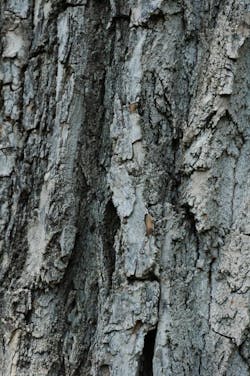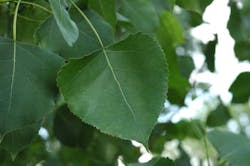Why Cottonwood Species Are a Problem
Cottonwood (Populus sect. Aigeiros) is a North American poplar species that grows anywhere from 70 to 190 feet tall. While majestic in appearance, cottonwood varieties can grow up to 6 feet annually and feature canopies that spread up to 75 feet wide. Their expedited growth rate often yields thick long branches composed of brittle wood that is susceptible to breaking in windstorms, which presents a threat to powerlines and utility infrastructure in the fall zone. These brittle remnants, as well as cotton produced by female cottonwood species, are highly flammable, which can impact the efficacy of wildfire mitigation programs.
What Do Cottonwood Species Look Like?
Three cottonwood species are commonly found throughout the United States:
- Eastern states: cottonwood (Populus deltoides)
- West of the Rocky Mountains: black cottonwood (Populus trichocarpa)
- California, Utah and Arizona: Fremont cottonwood (Populus fremontii)
While each of these species display smooth yellowish-green bark in the earlier stages of development, they become grayish-brown with scaly ridges as they approach full maturity.
Other distinguishing characteristics include the following:
Leaves
While the leaves of all cottonwood varieties have alternating flat stems, black cottonwood leaves are more oval-like. Comparatively, the leaves of eastern and Fremont varieties are triangular. Fremont and black cottonwood leaves are also more serrated than their eastern counterparts.
Fruit
The color of cottonwood fruit differs with each variety as well. While elongated three- to four-valved capsules grow in clusters on each, eastern cottonwood yields green or greenish-brown fruit, while Fremont cottonwood produces light-brown fruit, and black cottonwood fruit is darker with a hairy appearance. These capsules, also known as seedpods, only appear on female cottonwoods and can release a total of 25 million seeds each year.
Location
The cottonlike fluff that surrounds cottonwood seeds is dispersed by wind, which is part of the reason why cottonwood species can be found throughout Eastern, Central and Western regions of the United States. In each of these areas, cottonwood species commonly develop throughout the following sites:
- Riparian settings
- Seasonally dry creek beds
- Banks of waterways
- Edges of flood plains
- Deciduous forests
How to Control Cottonwood Species Effectively
Given the sheer size of cottonwood trees at full maturity, vegetation managers are encouraged to control these species in their earlier stages of development. While vegetation managers should follow directions provided on a product’s label to ensure the proper treatment(s) is used for the size and density of targeted vegetation, licensed applicators can apply the following treatments using Vastlan® herbicide from Corteva Agriscience to control problematic cottonwood trees at different stages of growth:
Shrub-sized Trees
- Foliar Spray
Foliar herbicide applications allow vegetation management teams to control targeted plants without having to remove the entire tree. After putting on personal protective equipment, a backpack sprayer can be used to treat targeted trees with low-volume herbicide applications. For areas where larger and heavier densities of trees are present, a hydraulic sprayer may be needed for high-volume applications. Always read the product label for recommended application rates.
Medium/Large Species
- Frill or Girdle
Make a single girdle through the bark along the circumference of the tree at a convenient height. The frill should allow for the herbicide to remain next to the inner stem and absorb into the tree. Be sure to wet the cut surface with an undiluted or diluted solution.
- Tree Injector
Completely surround the tree at a convenient height with injections through the bark at intervals of 3 to 4 inches between the centers of each injector wound. A solution of either 0.5 milliliter of undiluted Vastlan or 1 milliliter of a diluted solution should be used.
- Cut-stump Treatment
Spray or paint the cut surface of freshly cut stumps and stubs with undiluted Vastlan, ensuring the cambium area next to the bark is adequately wet.
- Chemical Side-trimming
Chemical side-trimming applications are designed to control only desired portions of targeted trees. TerraVue® herbicide from Corteva can be either used alone or tank-mixed with other labeled herbicides for effective chemical limb-trimming applications. Direct a spray solution of 2.85 ounces per acre to cover only the portion of the targeted plant and avoid spraying its crown to prevent inadvertent control of the entire tree.
- Basal Bark Treatment
Using a backpack sprayer, apply spray solution with the appropriate nozzle (flat fan or solid cone) to the lower 12 to 15 inches of bark to the ground level. Spray until the bark is wet but not to the point of runoff. Old or rough bark will require more spray than young, smooth bark. While these treatments can be completed at any time (unless snow or water prevents spraying to the groundline or when stem surfaces are saturated with water), 20 to 30 gallons of Garlon® 4 Ultra herbicide from Corteva can be mixed in enough oil to make 100 gallons of spray mixture to control susceptible woody plants with stems less than 6 inches in basal diameter.
To learn more about seasonal treatment opportunities or recommended treatment methods for other incompatible or invasive plant species, visit VMVistas.com.
TM ® Trademarks of Corteva Agriscience and its affiliated companies. Under normal field conditions, TerraVue® is nonvolatile. TerraVue has no grazing or haying restrictions for any class of livestock, including lactating dairy cows, horses (including lactating mares) and meat animals prior to slaughter. Label precautions apply to forage treated with TerraVue and to manure and urine from animals that have consumed treated forage. TerraVue and Vastlan® are not registered for sale or use in all states. Contact your state pesticide regulatory agency to determine if a product is registered for sale or use in your state. Consult the label for full details. State restrictions on the sale and use of Garlon 4 Ultra apply. Consult the label before purchase or use for full details. Always read and follow label directions. © 2022 Corteva.
Sponsored By:








